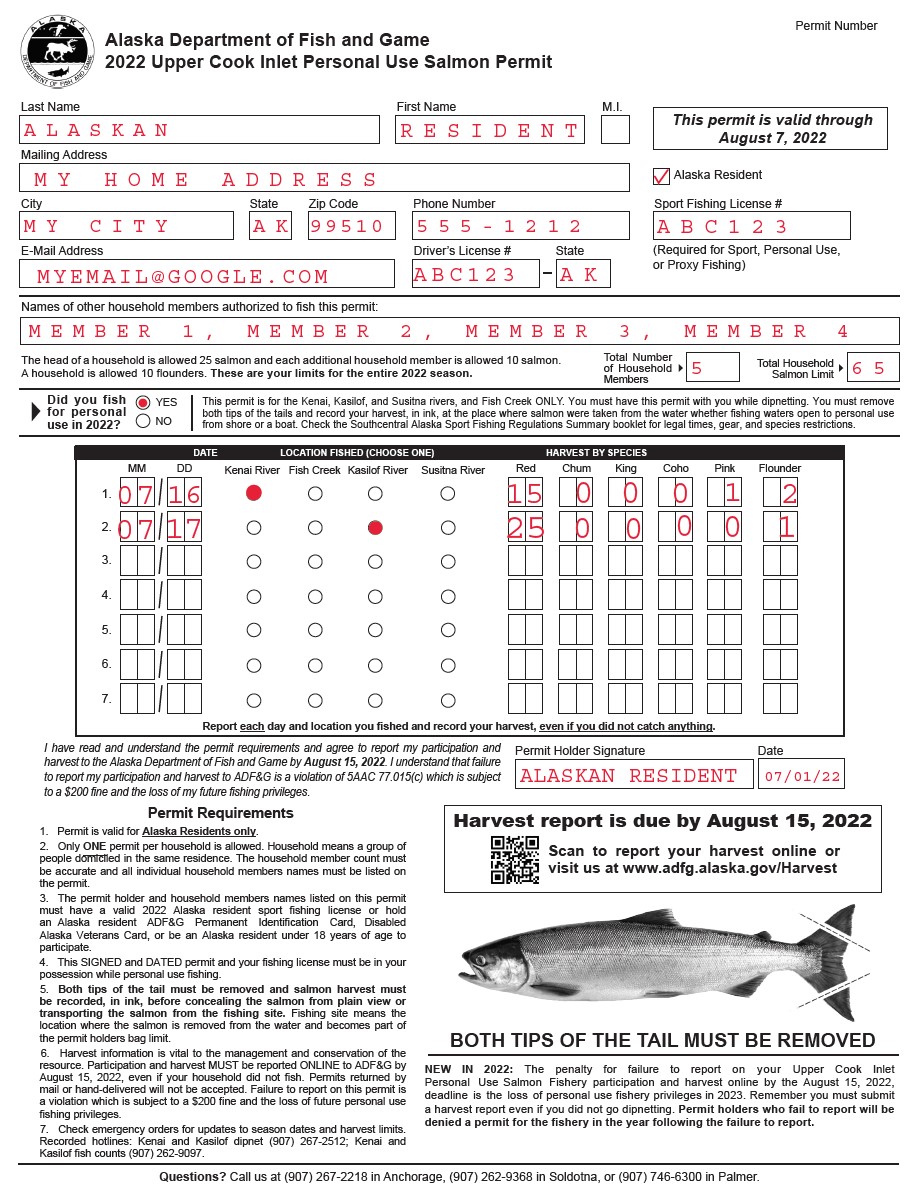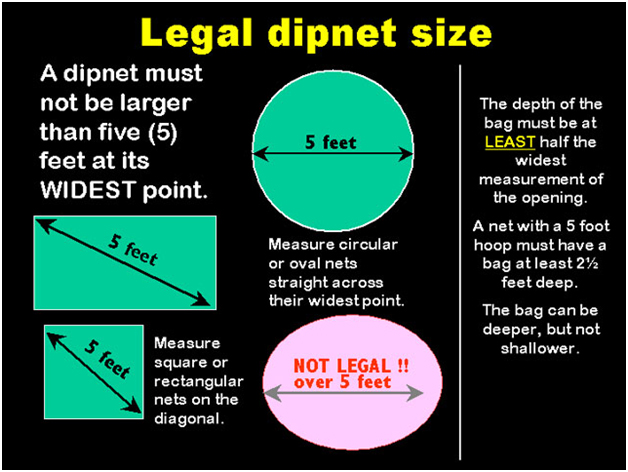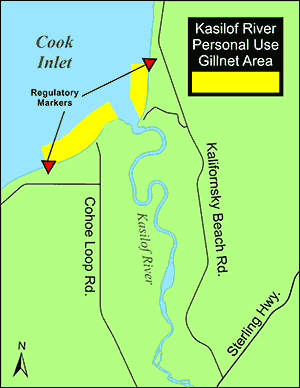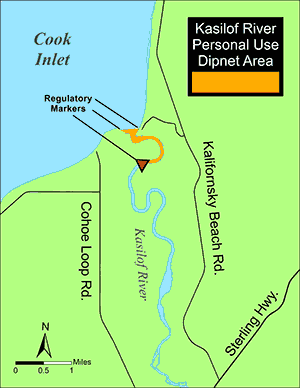Kasilof River Personal Use Salmon Fishery
Permits & Regulations
Kasilof River Online Permits & Reporting
Online Salmon and Shellfish Permits and Harvest Reporting - More Info
Online Harvest Reporting is Required
All Upper Cook Inlet Personal Use Salmon Fishery permit participation and harvest reporting must now be completed online through the ADF&G harvest reporting webpage.
- Online reporting will be required regardless if you purchase the permit through the ADF&G online store or through a vendor.
- Returning permits by mail or hand-delivery is no longer an acceptable means to report after 2021.
Harvest and participation must be reported online no later than August 15th, even if you did not use the permit, or if you did use the permit but did not catch anything.
To report online, enter your last name, permit number, and select Upper Cook Inlet Personal Use Salmon Permit for the appropriate year.
- If you don’t have your permit number available, you can look up your permit on the webpage.
- If you have questions about online harvest reporting, please contact your local ADF&G office.
Failure to Report and the Loss of Future Fishing Privileges
Even if you did not use the permit, and even if you did use the permit but did not catch anything you still have to report.
Beginning with the 2022 fishing season, the penalty for failure to report Upper Cook Inlet Personal Use Salmon Fishery participation and harvest online by the August 15th reporting deadline is the loss of personal use fishing privileges in 2023.
Permit holders who fail to report will be denied a permit for the fishery in the year following the failure to report.
To help you remember timely harvest reporting, be sure to provide a valid email address when obtaining your permit so that you will receive a reminder email near the end of the fishing season.
Stay Updated
Additionally, you can subscribe to receive Southcentral Region II – Northern Kenai Peninsula and Mat-Su / West Cook Inlet Emergency Orders and Press Releases email notifications.
To participate in any personal use fishery, you must be an Alaska Resident, and possess a valid Sport Fishing License or ADF&G senior license or ADF&G Disabled Veteran's License.
A permit is required to personal use dipnet for salmon in Kasilof River.
Permits can be obtained from private vendors or at Fish and Game offices in Fairbanks, Anchorage, Palmer, Soldotna, and Homer.
Households may not have both the Upper Cook Inlet Personal Use Salmon Permit and the Kachemak Bay Coho Salmon Set Gillnet Permit. Households must choose one or the other permit.
Personal use permits are household permits. This means that only one permit is required per household. However, all participating members of the household who are 18 years old or older must also have an Alaska resident sport fishing license, ADF&G senior license or ADF&G Disabled Veteran's license to participate, and must be named on the permit.
Permits must be filled in each time you fish
You must record the date, location, and harvest by species each time you fish. You must fill in this information even if you did not catch any fish—write "0" in the space provided for harvest.
The salmon must be recorded on the permit before it is concealed from plain view, such as put in a cooler, or before the salmon is transported from the fishing site, such as your vehicle. Failure to record the salmon on the permit is a violation, and may be subject to fines and loss of future personal use fishing privileges.
SAMPLE PERMIT

**If you did not catch any fish, put the day you went fishing, select where, and write zero's for quantity.
Seasons
Kasilof River dipnetting is open from June 25th to August 7th.
Kasilof River gillnetting is open from June 15th to June 24th.
Bag limits
The total yearly harvest out of all the Upper Cook Inlet personal use salmon fisheries (Kenai, Kasilof, and Fish Creek) is 25 salmon and 10 flounder for the permit holder and 10 salmon for each additional household member. The limit is combined for all four fisheries—Kenai dipnetting, Kasilof dipnetting, Kasilof set gillnetting, and Fish Creek dipnetting.
No king salmon may be kept in the Kasilof River dipnet fishery. King salmon caught in the Kasilof River personal use set gillnet fishery may be retained.
These are annual household limits, not a daily limit, or a limit per fishery.
Personal use salmon required to be "marked"
By regulation, you must "mark" salmon harvested in a personal use fishery in which a permit is required by clipping both tips of the tail fin. Scissors or shears are the best way to cut off the tips of the tail fin.
The salmon must be marked before the salmon is concealed from plain view, such as put in a cooler, or before the salmon is transported from the fishing site, such as your vehicle. Failure to mark the salmon is a violation, and may be subject to fines and loss of future personal use fishing privileges.

Legal gear: dipnet
In 5 AAC 39.105 of the Alaska Administrative Code, a dipnet is defined as
- a bag-shaped net supported on all sides by a rigid frame;
- the maximum straight-line distance between any two points on the net frame, as measured between any two points on the net frame, as measured through the net opening, may not exceed five feet;
- the depth of the bag must be at least one-half of the greatest straight-line distance, as measured through the net opening;
- no portion of the bag may be constructed of webbing that exceeds a stretched measurement of 4.5 inches;
- the frame must be attached to a single rigid handle and be operated by hand.
This definition applies statewide, to both salmon and herring/hooligan dipnet fisheries.

Legal gear: set gillnet
5 AAC 39.105 defines a set gillnet as "a gillnet that has been intentionally set, staked, anchored, or otherwise fixed." See the Kasilof River set gillnet fishery web page for additional gear restrictions.
The following requirements for Kasilof River personal use set gillnetting are in addition to the regular requirements of a set gillnet:
- A Kasilof River personal use set gillnet may not exceed 10 fathoms (60 ft) in length, 4 ¾ inches in mesh size, and 29 meshes in depth, and
- No part of a Kasilof River set gillnet may be operated within 100 feet of another set gillnet, and
- A person may not operate more than one set gillnet, and only one set gillnet may be operated per household, and
- The permit holder shall attend the set gillnet at all times when it is being used to take fish.
There are no inherent rights establishing a set gillnet fishing site. The placement of signs, running lines, stakes, buoys, or dry nets on the beach in anticipation of tides does not constitute any prior right to a net location.
View the Kasilof Gillnet Specifications Guide
Set or drift gillnet web requirements
Gillnet web in a gillnet used for fishing for salmon must meet one of the following requirements:
- The web must contain at least 30 filaments and all filaments must be of equal diameter, or
- The web must contain at least six filaments, each of which must be at least 0.20 millimeter in diameter.
Gillnet or pot marking requirements
Each personal use fisherman shall plainly and legibly inscribe his or her first initial, last name, and home address on a keg or buoy attached to a gillnet or pot. A keg or buoy attached to a pot must also be inscribed with the name or US Coast Guard number of the vessel used to operate the pot.
Area open to set gillnetting and dipnetting
Gillnetting is allowed in salt waters only, about 1 mile north and south of the Kasilof River mouth, as defined by ADF&G markers. Fishing is prohibited beyond 1 mile from the mean high water mark, and is also prohibited within the flowing waters or over the stream bed or channel of the Kasilof River at any stage of the tide.
Dipnetting is allowed from ADF&G markers posted on Cook Inlet outside of the mouth of the Kasilof River, to about 1 mile upstream to ADF&G markers.


Kasilof River north shore access
To access the north shore, take Kasilof Beach Road, which is off the south end of Kalifornsky Beach Road.
Do not drive through the private property signs at the cannery. You may park your vehicle off the driving surface, but staying within the road right-of-way. Four-wheel drive is recommended due to the softness of the sand off the driving surface.
Please do not park on the sand dunes—the beach grasses can not survive the impacts.
Kasilof River south shore access
To access the south shore, turn west on North Cohoe Loop Road, off the Sterling Highway. When the pavement turns to the south (left), continue west (straight) on the rough, unpaved dirt road to the beach. The mouth of the Kasilof is approximately 1/4-mile north (right) along the beach. Four-wheel-drive is necessary to get to the mouth on the south shore. Don't drive anything you can't get unstuck, such as a motorhome, down the beach. It is very expensive to get towed.
Dipnetting from a boat
Dipnetting from a boat is allowed during the same open season and times as dipnetting from shore. The same permit, harvest limits, and marking requirements apply. The open area is the same as that of the shore dipnetting area. There are no nearby public boat launches. The nearest public boat launch is just upstream of the Sterling Highway bridge.
